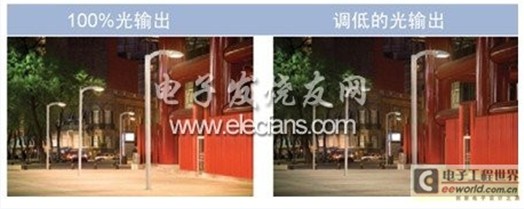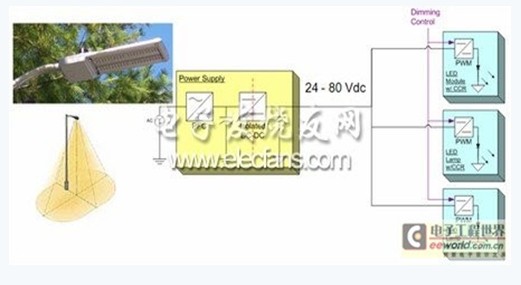According to statistics, up to 20% to 22% of electrical energy is used for lighting. Increasing the energy efficiency of lighting applications and even further reducing their energy consumption will help reduce carbon dioxide emissions and create a greener world. Therefore, energy-efficient lighting is becoming a focus of competition in the industry. There are many challenges in high-power area lighting, such as the possibility that the luminaire may be difficult to access, the safety problem may occur when the light source fails, and there are many extreme environmental conditions in the outdoor. In addition, it should not be overlooked that existing light sources (such as metal halide lamps, high pressure sodium lamps, linear fluorescent lamps, and compact fluorescent lamps) used in high-power area lighting have many limitations, such as poor color rendering of high-pressure sodium lamps (CRI is about 22), the typical luminaire loss of metal halide lamps is higher (40%) and the time from start to illuminate to full brightness may be as long as 10 minutes, the cold temperature performance of linear fluorescent lamps is poor, and the starting speed of compact fluorescent lamps is also higher. SLOW. On the other hand, as high-brightness white light-emitting diodes (LEDs) continue to improve in terms of performance and cost, they are increasingly used for high-power area lighting and offer advantages not found in traditional light sources, such as emitting light per lumen. It consumes less power, has better direction control, better color quality, is environmentally friendly, and can be more easily controlled by turning it on and off, allowing automatic detection of ambient light to change brightness; in addition, LED reliability is better, which is beneficial to the LED. Reduce maintenance costs and total cost of ownership. LED area lighting application requirements The main function of the LED driver is to flow at a lower limit of various conditions and to protect the LED from surges and other fault conditions, as well as to provide a level of safety against vibration and ignition (electrical and/or mechanical). For regional lighting applications, outdoor environments present temperature challenges to LED drivers and may require AC input voltages higher than the standard voltage of 277 Vac, 347 Vac, or even 480 Vac. LED drivers for regional lighting applications may also need to meet certain specifications for power factor or harmonic content. For example, the European Union's International Electrotechnical Union (IEC) IEC61000-3-2 standard requires harmonic content of lighting equipment (class C) with a power exceeding 25 W, equivalent to a total harmonic distortion (THD) of less than 35%; However, compliance with IEC61000-3-2 Class C harmonic content requirements does not necessarily mean that the power factor (PF) is higher than 0.9. In some markets (such as the US), PF is generally required to be above 0.9 and THD is below 20%. Many regional lighting applications are outdoors and may withstand a variety of stringent temperature conditions, which can affect overall service life. While the overall system design has a significant impact on service life, it is important to use an energy-efficient LED driver with less internal heat generation and lower losses, and to thermally isolate the driver from the LED heat source in the design to enhance system reliability. Figure 1: Example of a smart dual brightness level LED street lighting. The control of LED lighting can also become more intelligent. Traditional street lights come from the main control with a timer or ambient light sensor. The use of power line communication (PLC) or wireless control technology can provide highly flexible LED area lighting control, such as time-based light output level centralized control, vehicle flow sensor based lighting level control, and control based on detection of people and vehicle activity. Downtown lighting, taking care of walking cars and street lighting. LED intelligent control technology saves energy and does not compromise safety. Typical applications include smart dual-brightness lighting, such as parks, gas station ceilings, parking lots, stairs, and refrigerator cabinet lighting that support lighting levels that adjust brightness levels as needed. LEDs can be turned on and off instantly, allowing for easy adjustment of lighting levels based on motion or activity in these applications, such as providing 20%-40% brightness levels when no activity is detected and 100% when activity is detected Brightness lighting. This will save a lot of extra power consumption. LED area lighting power architecture and typical LED driver solution 1) Distributed/modular solutions for applications such as linear lamps and trunking lamps In the high-power LED area lighting application, a common power supply architecture is a three-stage architecture of "power factor correction (PFC) + constant voltage (CV) + constant current (CC)". In this architecture, the AC input power supply is subjected to power factor correction and isolated DC-DC conversion, and a fixed voltage of 24 to 80 Vdc is output to the constant current LED of the built-in DC-DC buck converter circuit. Module (see Figure 2). The design of this architecture provides a modular approach to field upgrades that can flexibly change the number of LED strips as needed to increase or decrease the light output to meet specific area lighting application requirements. In this architecture, AC-DC conversion and LED driver circuits are not integrated, but distributed configuration, which simplifies security considerations and enhances system flexibility. It is also called distributed solution, typical application. Including linear lights and trunking lights. In this modular approach, a design can be extended for multiple light output levels. Moreover, as the LED light output performance is enhanced, the LED module must provide the same light output level, and the required light bar is better. Each light bar has a dedicated DC-DC. Figure 2: Schematic diagram of a typical modular LED area lighting power supply architecture.
AVS, AVSS, TXL, GXL, UL2464,UL1015,UL1007 normally used for Car Alarm Wiring. JST, Dephi, Molex, and Chinese equipvalent part canbe assembly in the harness. Yacenter expands oversea markets, such as Europe, America,Janpan, etc. Owing to the rapid development, Yacenter has been awarded as [UL, CE, TS"certificate.
Any technical question, inquiry price, feel free to communicate with us.
Car Alarm Wiring Car Alarm Wiring,Car Alarm Wire Harness,Automobile Car Alarm Wire Harness,Car Stereo Alarm Wiring Harness Dongguan YAC Electric Co,. LTD. , https://www.yacenter-cn.com
